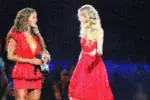“Trainwreck: The Women We Love to Hate, Mock, and Fear . . . and Why” by Jude Ellison Sady Doyle delves into the “train-wreck phenomena” to explain why society gawks at the downfall of the influential women who defy norms, and what we can learn from their stories.
When thinking of the word “trainwreck,” a few poignant images come to mind. Maybe it’s the imagery of a literal train collision, or perhaps something less literal. It could be the image of Britney Spears wielding an umbrella as she desperately attempts to get the paparazzi to leave her alone. Maybe it’s Lindsay Lohan drunkenly stumbling through a Hollywood premiere party while flashing cameras obstruct her path. One could even think of Taylor Swift writing one too many vulnerable ballads about her relationship struggles and garnering the reputation of the nation’s “crazy ex-girlfriend.” Contrary to the vast differences in these descriptions, all of these women have one thing in common: They are all women who have been labeled “trainwrecks.”
Jude Ellison Sady Doyle is an American author with a prolific repertoire of research and knowledge of feminism under their belt. Their 2016 book, “Trainwreck: The Women We Love to Hate, Mock, and Fear… and Why,” is a brilliant book that seeks to dismantle the sexist narratives that plague the media. Their extensive work into researching social dynamics reads clearly in “Trainwreck,” as the book examines feminism through a variety of sociological lenses. From frames of heteronormative standards to racial stereotypes, “Trainwreck” bravely attacks the cyclical framework our society has perpetuated for far too long.
From exploring what makes a trainwreck, all the way to what we can do to correct the cycle, the book speaks to readers who can’t help but wonder what makes a woman fall from “idol” to “trainwreck.” In the first chapter, Doyle boldly writes, “As the trainwrecks keep popping up through our social media timelines and gossip blog feeds, as the social media pile-on and hate reads keep on coming, as this girl continuously arises, scandalizes, flames out, and is replaced, it’s hard to avoid the conclusion that we have a vast and insatiable appetite for specifically female ruin and suffering.”
The Anatomy of a Trainwreck
Despite the negative connotations of the word trainwreck, Doyle describes trainwrecks as women who unintentionally become feminist icons because of the boundaries they break in the wake of their scandals. Doyle traces the history of this pattern beginning with the life and posthumous fame of Mary Wollstonecraft and brings it full circle to celebrities of today. It becomes apparent that even centuries since Wollstonecraft, society is not progressing when it comes to how we treat women.
To explain why this ideology remains, Doyle writes: “So, we may wreck people simply to validate ourselves. We may wreck them because we’re jealous. We may wreck them because we fear the sight of public suffering, or because, well, everyone else hates them, so they must have done something to deserve it. Maybe. But then, there’s my favorite theory: Maybe we wreck people because they’re women.” A woman doesn’t become a trainwreck because she decides to be one, she gains the label of a trainwreck as a result of how we perceive her and her actions.
The Trainwreck Witch-Hunt
Previous examples of trainwreck women all seem to bear the same hallmarks — whether it be falling into substance abuse, getting caught with the wrong crowd, or showing too much emotion in public. However, despite how cut-and-dry the path to media vilification seems to be, Doyle presents examples of women who show the inescapability of trainwreck culture.
For example, the lives of Taylor Swift and Miley Cyrus. By all accounts, both women’s entrances into stardom were perfect. They both embodied the ideal, wholesome All-American girl that the public idolizes. Seemingly overnight that idolization changed once the young girls approached adulthood. Media outlets began almost witch-hunting and eagerly awaiting the moment they could catch one of the young starlets slipping down an unsavory path and make it headline news. Though both were under the pressures of the same constant scrutiny, their paths began to diverge. While Swift clung to her pure image to maintain her reputation, Cyrus decided to do something women in the public eye rarely do — she took back her narrative.
Instead of letting the media catch her in the act of something, Cyrus has been unwaveringly open about her explorations of recreational drug use, her sexuality and gender identity. Upon noticing this, the media went wild with news of all of her scandalous behaviors and beliefs. Her choice to be open about these topics caught media outlets, who were waiting to catch her in the act, off guard.
On the surface, she was doing everything they wanted her to do. Cyrus was behaving wildly and they were able to capture it like they were waiting to. The only difference was she was doing this of her own volition. Cyrus wasn’t desperately trying to hide her ventures, she was embracing it. Miley Cyrus was choosing to play their game and win.
What We Can Learn From Trainwrecks
Throughout the entire book, my stomach turned as I began to understand the true problem the book centers on: the silencing of women and our complicity in it. As a woman, I felt shame knowing I unintentionally was a part of the trainwreck cycle by failing to see these women as victims and not just as entertainment. Though we may not have been actively participating in creating tabloid headlines, we were complicit in allowing news publications to believe capitalizing on harassing women is okay. Each story Doyle tells of women enduring harrowing torment isn’t to exploit their pain, it’s to show readers that these women are more than their mistreatment and deserve to be treated as such.
“Trainwreck” isn’t a book written to be a simple read; it’s meant to unease you. The details of all of the women and their struggles are meant to make you see the humanity in women that are victims of trainwreck culture. It’s a call to action meant to make readers question the systemic misogyny that silences women all over the world regardless of their status. In Chapter 5, Doyle writes, “… silence is not just an unlucky outcome, for a woman. It may be the natural outcome—as far as many people are concerned, the ideal outcome—of being female in a sexist world.”
The most important message to extract from “Trainwreck” is the need to oppose the widespread complicity in watching women’s downfall. Whether you admit it or not, we are all guilty of standing by as women get relentlessly torn apart in the media. From sharing memes of pop stars in their weakest moments, speculating about who has had what cosmetic surgery and the dehumanization of any woman in the public eye who openly expresses that she does not always fit the cookie-cutter role model society wants her to.
Doyle believes in all of these women, and in these women, we can see reflections of ourselves. Doyle writes, “It’s an effort to figure out who she is: why she’s making us so angry; what, in general, she hath done to offend us. When women look hard enough at the trainwreck, we almost invariably end up looking at ourselves.”
“Trainwreck” shows readers that uplifting women isn’t just celebrating women society deems acceptable; it’s ensuring the voices of women who dare to go against the current are celebrated too. Above all, “Trainwreck” seeks to dismantle the idea that women should not be victims of a culture that seeks to tear them down the moment they show that they’re human too. Doyle effortlessly articulates this sentiment when they write: “Women are not symbols of superhuman virtue. Women are not symbols of all that is disgusting and corrupt. Women, it turns out, are not symbols of anything, other than themselves.”
















